U.S. Review
Economic Expansions Don’t Die of Old Age
- On Monday, the current economic expansion entered its 121st month, marking the longest expansion in modern American history.
- Despite caution that has accompanied the longevity of this expansion, recent data indicate a moderating rather than a contracting economy.
- Employers added 224,000 jobs in June, and the unemployment rate rose to 3.7%. Survey results from the manufacturing and service sector were mixed, but suggest some further slowing this year.
Economic Expansions Don’t Die of Old Age
On Monday, the current economic expansion entered its 121st month, marking the longest uninterrupted expansion in modern American history. The sheer age of the expansion has caused heightened speculation in recent months of when the next downturn will transpire. But, economic expansions do not simply ‘die of old age’. Expansions expire due to a policy misstep or when a growing imbalance in the economy finally surfaces.
Despite the caution that has accompanied the longevity of the expansion, recent data indicate a moderating rather than a contracting economy. This morning we learned employers added 224K jobs in June. That pushed the three-month average up to 171K, but the 172K average over the first six months of this years is down fairly substantially from the 211K average the prior six months. The unemployment rate edged back up to 3.7%, and wage growth came in a touch weaker than expected at 0.2% (3.1% on a year-ago basis). Factory activity continues to struggle due to tariffs. Although the ISM manufacturing index held up better than expected in June at 51.7, the new orders component of the index barely skirted a contractionary print and, at 50.0, hit a three-anda- half-year low. The services sector, on the other hand, has been more resilient to trade uncertainty. The ISM non-manufacturing index remained firmly in expansionary territory, though concern specifically regarding tariffs was noted by respondents.
Further escalation in the trade war with China looks less likely after the meeting between Presidents Trump and Xi at the G20. But we still suspect a complete resolution with China is likely some ways off. Therefore, while businesses’ fears about an imminent all-out trade war have been allayed, uncertainty about the structure of future trading relations continues to linger and will likely weigh on business spending this year.
Trade is also taking a hit. Trade data through May show goods exports have yet to return to their peak which occurred in May 2018—the month before the steel and aluminum tariffs went into effect and the trade war began in earnest. Tariffs have not reduced overall imports, nor have they made a dent in the overall trade deficit, which has widened 27.7% since the start of 2017. Instead, domestic importers may be re-routing foreign supply chains. See Topic of The Week on Page 7 for more detail.
Fed Chair Powell will testify before the Senate Banking Committee on Thursday, and FOMC members Williams, Bostic, Barkin and Kashari are also set to speak at other engagements. Market participants are likely to listen for Fed speakers to telegraph how recent data are impacting the policy outlook. Financial markets have already priced in 100% probability that the Fed will cut rates at the end of the month. On this assumption, financial markets have soared with the S&P 500 and Dow Jones Industrial Average both reaching all-time highs this week. While we also look for the Fed to cut rates 25 bps on July 31, rather than viewing this as a turn to easing to stave off an imminent downturn, we view the Fed taking an “insurance” cut to, in part, get ahead of a true deceleration. While economic expansions don’t die of old age, they don’t last forever. This one still looks to have some room to run.
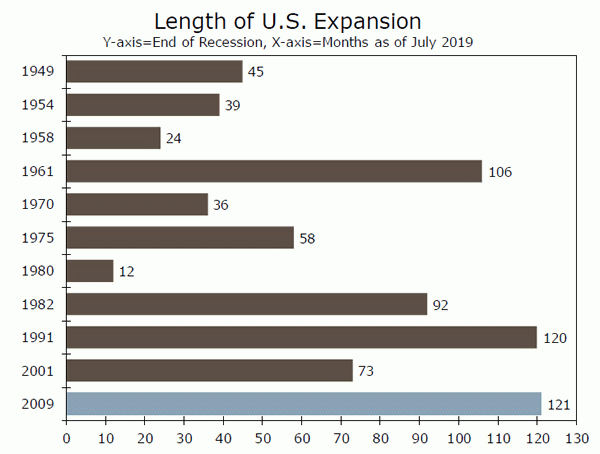
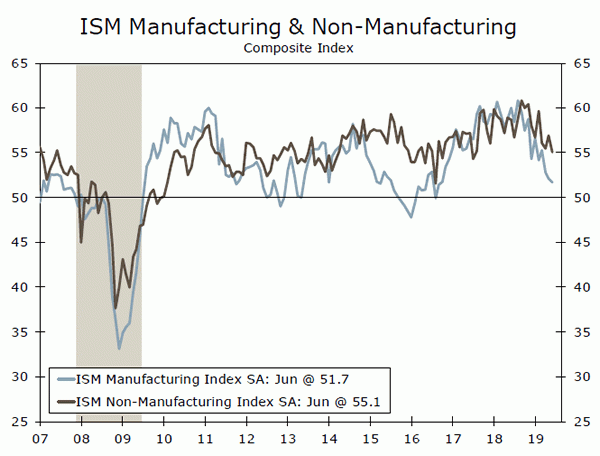
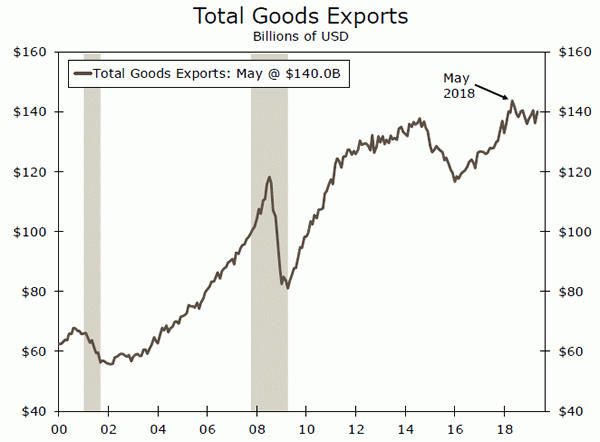
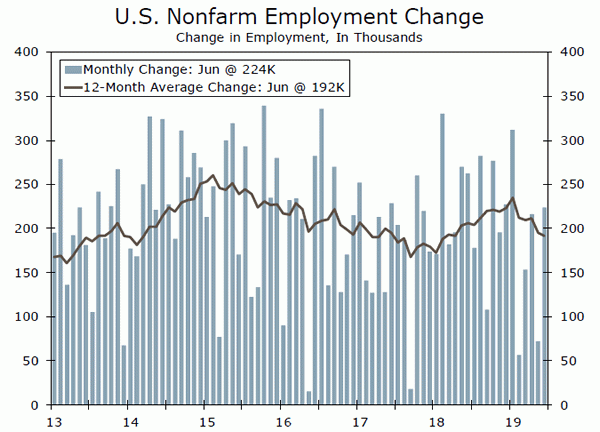
U.S. Outlook
Consumer Credit • Monday
Consumer debt (excluding mortgages) increased by the most in five months in April, suggesting consumers remain upbeat in regards to their spending habits despite elevated uncertainty over the outlook. Total credit expanded $17.5 billion from March, with revolving debt outstanding rising by the most since November 2018 and nonrevolving credit increasing the least since June 2018.
The strength of the labor market has underpinned the economic expansion which, in turn, has given consumers the confidence to tap credit lines. Rising incomes and solid overall economic growth have helped combat higher financing costs, as the debt service ratio remains well below its pre-recession peak. As long as the labor market remains healthy, consumer credit is likely to expand further. For May, the consensus looks for total consumer credit to expand $15.0 billion, slightly lower than its YTD average of $15.3 billion.
Previous: $17.50B Consensus: $15.00B
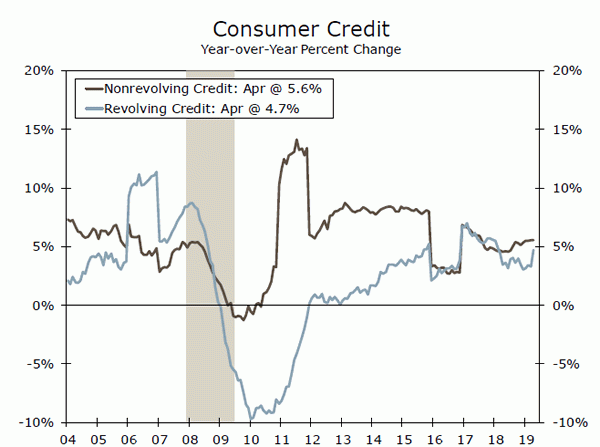
FOMC Meeting Minutes • Wednesday
Focus on monetary policy comes front and center next week as Chair Powell delivers his semi-annual testimony before the House Financial Services Committee on Wednesday and the Senate Banking Committee on Thursday. Additionally, the minutes to the June FOMC meeting are published on Wednesday.
Keeping rates unchanged in June, the Fed clearly shifted tact and indicated they are prepared to ease monetary policy at upcoming meetings due to increased uncertainty over the outlook. We suspect Chair Powell will reiterate those same concerns to Congress, thereby keeping the door open to a rate cut at the July FOMC meeting.
In regards to the meeting minutes, interest will be high for any additional details on the balance sheet that could suggest an earlier end to tapering or further discussions on the equilibrium size and composition.
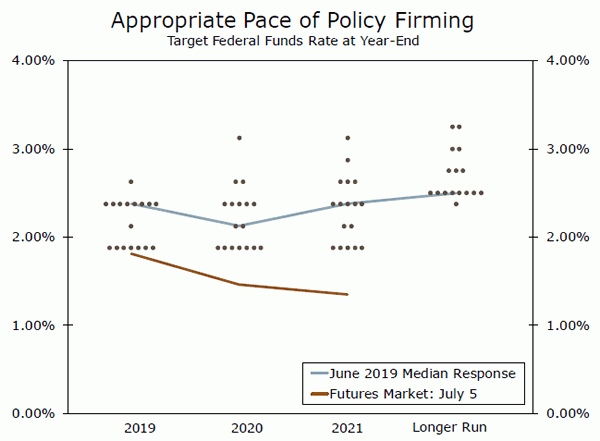
CPI • Thursday
Inflation and inflation pressures remain tame as the calendar rolls into the second half of the year. In May, the headline Consumer Price Index advanced just 0.1%, with the core CPI increasing 0.1% for the fourth consecutive month.
Looking at June, we project the core CPI to rise 0.2% on the month, which, if realized, would keep the annual pace steady at 2.0%. Used motor vehicle prices, which have been a meaningful drag on core goods prices in recent months, are poised to stop deteriorating.
We do not anticipate a meaningful impact of the escalated tariffs in this month’s report. Imports from China that entered the U.S. before June 15 were not subject to the additional 15% tariff rate–from 10% to 25%.
Previous: 0.1% Wells Fargo: 0.2% Consensus: 0.2% (Core CPI, Month-over-Month)
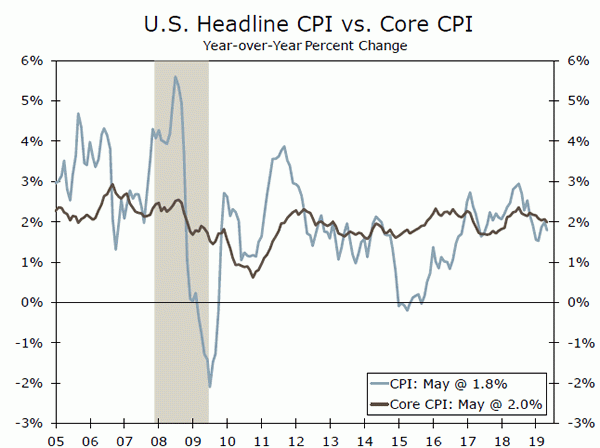
Global Review
Global Economy at Least Not Getting Worse
- Data released this week showed South Korean export volumes still contracting on a year-over-year basis through May, though the pace of decline appears to have leveled off.
- In the United Kingdom, the manufacturing PMI fell precipitously to 48.0. In the Eurozone, the manufacturing PMI also remains below 50, but the service sector continues to show resiliency, helping to keep economic growth positive.
- Canadian employment growth cooled in June, but the decline was entirely concentrated in part-time employment.
Global Economy at Least Not Getting Worse
The South Korean economy is a relatively open, trade-oriented economy with close trade ties to China in particular. South Korea’s exports are about 44% of its GDP, and about one quarter to a third of those exports go to China. Thus, when South Korean real export growth turned decisively negative around the turn of the year, the data raised concerns about the global economy generally and China specifically.
Data released this week still showed South Korean export volumes contracting on a year-over-year basis through May, though the pace of decline appears to have leveled off (see chart on front page). The most recent round of tariff escalation between the United States and China did not go into effect until June 1, however, which means another leg down could be in store. To that point, the Caixin China manufacturing PMI slipped back into contractionary territory this week, falling to 49.4 in June from 50.2 in May.
Manufacturing PMIs in Europe released this week were not much better. In the United Kingdom, the manufacturing PMI fell precipitously to 48.0 (more on that in the global outlook section). In the Eurozone, final PMI readings for June showed the Eurozone manufacturing sector still stuck in contractionary territory. Encouragingly, however, the service sector has remained resilient, and the European PMI for services has even risen a couple points from its recent low in December 2018 (top chart).
Resiliency in the larger service sector has been key to supporting growth and preventing the Eurozone from slipping into a recession. Despite the slowdown in Eurozone economic growth that has taken place over the past year, the unemployment rate has continued to fall. The Eurozone unemployment rate is down 0.8 percentage points since May 2018 and 0.4 percentage points since the end of last year (middle chart). This is not to say the nonmanufacturing sectors have been unaffected by the slowdown. Inflation-adjusted retail sales data released this week showed month-over-month sales growth contracting for the second consecutive month and decelerating to a 1.3% year-over-year gain.
Canada’s labor market started the year on a tear with some of the largest job gains of the expansion (bottom chart). Data released this morning showed Canadian employment growth cooled in June, with total payrolls declining 2,200. The decline was entirely concentrated in part-time employment, however, as full-time employment rose 24,100 jobs in June. Wage growth jumped sharply in June, though some of this may have been due to a minimum wage increase in British Columbia.
Not only has full-time employment been growing at a solid rate, but the private sector has done nearly all of the heavy lifting in this recent run of job gains. On a year-over-year basis, private sector payrolls in Canada are up 354,000, or about 3%, while government employment is little changed over the past 12 months. Even in Canada, however, the global weakness in manufacturing was noticeable in this morning’s data. Canadian employment in manufacturing was down 15,000 in June, the first monthly decline in nearly a year.
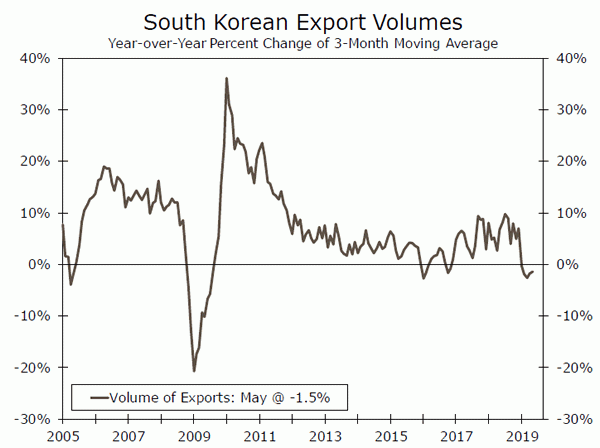
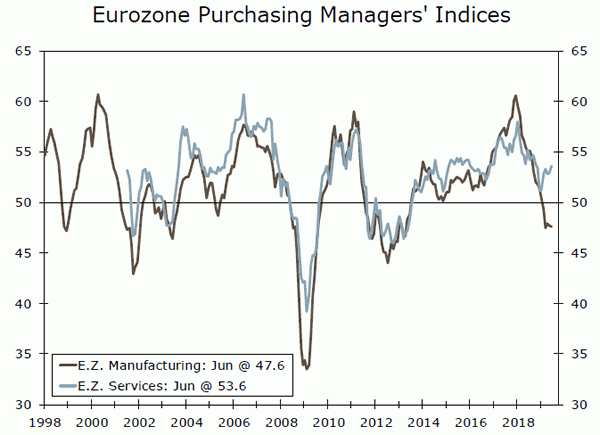
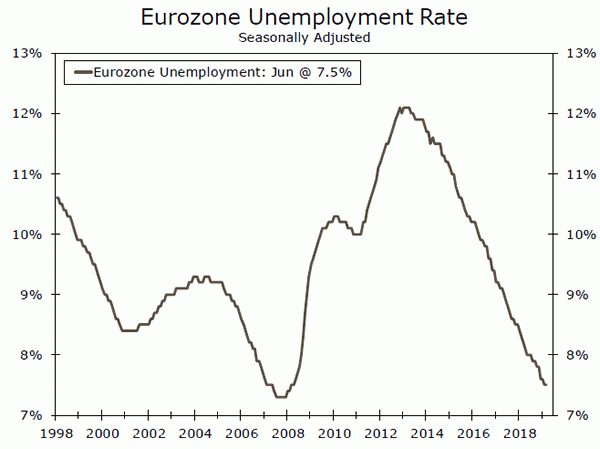
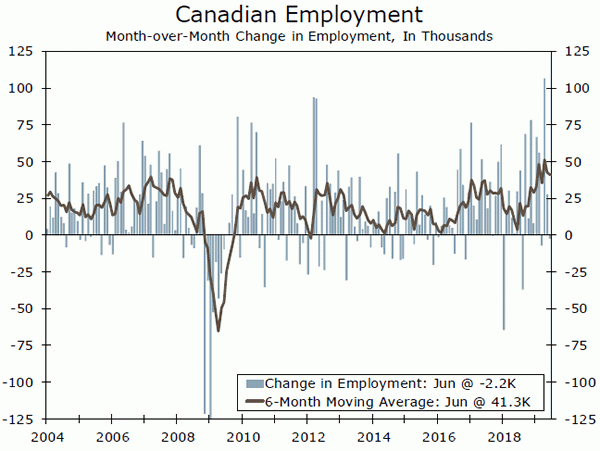
Global Outlook
U.K. Monthly GDP • Wednesday
Earlier this year, some analysts were surprised by the resiliency of the U.K. economy given the ongoing Brexit struggle and the general slowdown in the global economy. More recently, however, the data have started to show more signs of slowing in the United Kingdom. As mentioned in the global review section, the U.K. manufacturing PMI fell precipitously in June to 48.0, while real retail sales ex-autos and fuel declined for the second consecutive month in May.
Next week’s monthly GDP release for May will offer some additional details on this slowdown, including the extent to which it has been concentrated in manufacturing. Monthly GDP declined 0.4% in April, but almost the entire decline was attributable to factory output. We believe this slowdown is, to some extent, driven by an inventory correction. We will be watching next week’s data to see if the factory sector slows further and/or if the weakness spreads to the service sector of the U.K. economy.
Previous: -0.4% (Month-over-Month) Consensus: 0.3%
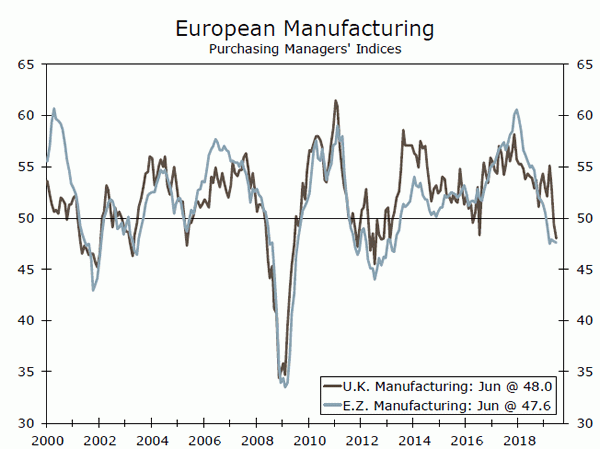
Bank of Canada Meeting • Wednesday
When the Bank of Canada (BoC) last met on May 29, its policy statement adopted a relatively upbeat tone. The BoC noted that “recent data have reinforced Governing Council’s view that the slowdown in late 2018 and early 2019 was temporary.” Employment growth has been especially strong in Canada over the past several months, both for full- and part-time workers.
In the aforementioned statement, however, the BoC qualified the line from above with “although global trade risks have increased.” The day after that BoC meeting, President Trump threatened escalating tariffs on Mexico that sparked a brief but intense round of negotiations. At present, financial markets are only pricing in 22 bps of easing in Canada over the next 12 months, compared to about 90 bps in the U.S. and 120 bps in Mexico. Given the stabilizing economy, inflation near target and housing sector risks, we expect the BoC to keep policy unchanged through the end of 2020.
Previous: 1.75% Wells Fargo: 1.75% Consensus: 1.75%
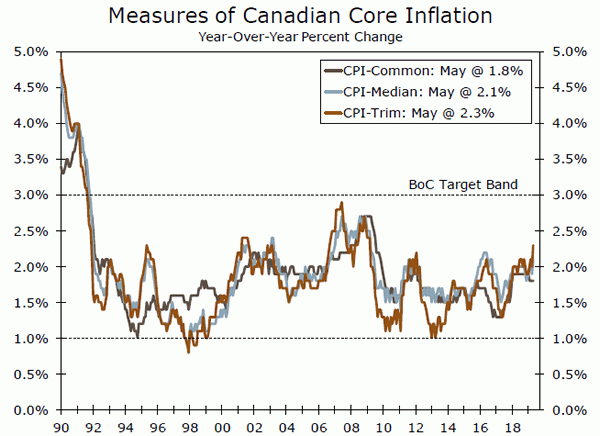
Eurozone Industrial Production • Friday
As discussed in the global review section, the slowdown in the Eurozone economy has been defined by a lagging manufacturing sector and a resilient service sector. This is perhaps best illustrated in Germany, Europe’s biggest economy and manufacturing powerhouse. Factory orders in Germany are contracting at a pace not seen since the Great Recession.
The Eurozone-wide industrial production data released next week will be for May, right before another round of tariffs went into effect between the United States and China. On a year-over-year basis, industrial production was down 0.4% in April, but this small decline masks worrying trends in the details. Capital goods and durable consumer goods production were down 1.2% and 0.8%, respectively, partially made up for by growth in non-durable goods. Another decline in industrial output broadly and cyclically-sensitive sectors specifically would be a poor sign for the Eurozone economy.
Previous: -0.5% (Month-over-Month) Consensus: 0.2%
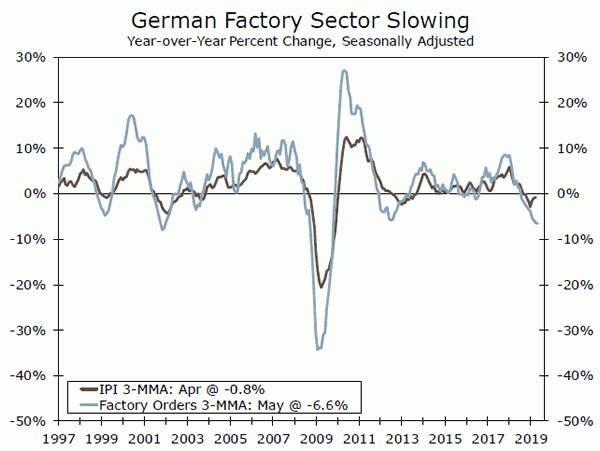
Point of View
Interest Rate Watch
Debt Ceiling Coming Into Focus
Yields on most Treasury securities were a bit higher on the week relative to their close last Friday, but the yield on the 3-month bill rose the most (top chart). Although the federal government’s debt ceiling may not seem very relevant to many observers at present, it is starting to attract the attention of bond market participants.
The Treasury Department has been operating recently to keep the government under the $21.99 trillion debt ceiling, which was re-instated on March 2. Many analysts, including us, estimate that Treasury will run out of “extraordinary” measures to keep the government under the debt ceiling during the first week of October when large disbursements are scheduled to be paid.
Moreover, the federal government’s fiscal year ends on September 30, and many analysts believe that a new budget will be paired with an increase in the debt ceiling. Political gridlock in Washington could threaten the ability of the Treasury Department to make payments on time. In short, the federal government could potentially default in early October if the debt ceiling is not raised. The 3-month bill that was auctioned on July 1 will mature in early October, and payment could be delayed if the debt ceiling is not raised.
A similar phenomenon occurred in the summer of 2011 when the federal government came perilously close to defaulting on its debt. The yield on the 3-month Treasury bill rose nearly 10 bps in July 2011 (middle chart). The rate on the 1-month bill spiked more than 15 bps.
Unless the government actually defaults on its debt, most businesses likely won’t be affected by developments in the Treasury market. 1-month and 3-month LIBOR, which are relevant for most businesses, edged higher in July 2011 but largely because the market was starting to price in some Fed tightening, which ultimately did not occur (bottom chart). Likewise, LIBOR was largely unchanged this week despite the rise in bill rates. That said, a default by the federal government, should one occur, would impart significant volatility into financial markets. Stay tuned.
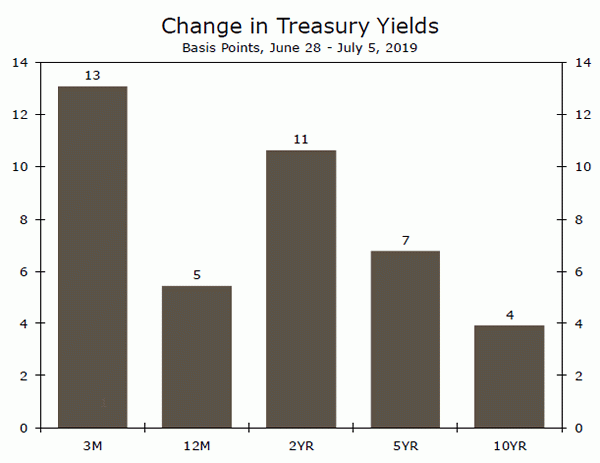
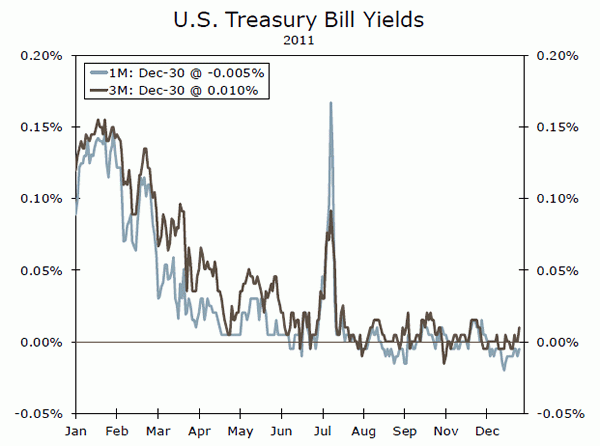
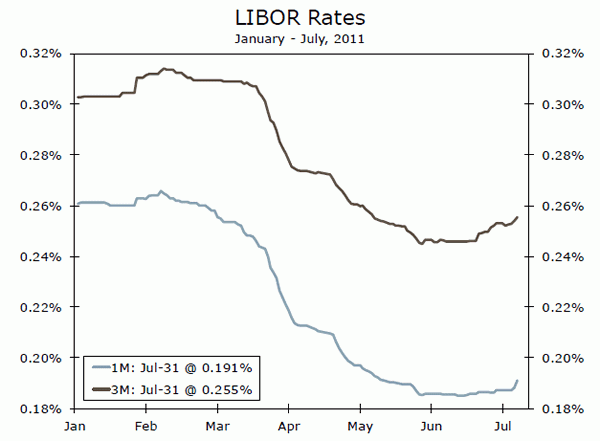
Credit Market Insights
Credit Index Remains in Expansion
Credit conditions eased slightly in June, yet remained solidly in expansion territory, according to the National Association of Credit Management’s Credit Managers’ Index (CMI). The CMI is a representative survey of 1,000 trade credit managers nationwide, and is broken down by sector with subindices for both manufacturing and services credit markets. The headline index fell to 55.0 from 55.7, but as it is a diffusion index, any reading above 50 indicates an improvement in credit conditions. Still, one year ago the CMI was sitting at 56.3. The dip in the index bears watching, but on the whole it has deteriorated less than other measures, including the ISM manufacturing and services surveys. Over the past year, the CMI has had six monthly increases and six monthly declines, likely as credit managers digested a steady stream of trade rumors, threats and new deals. Indeed, the manufacturing CMI has fared worse, declining six of the past nine months to 54.9 in June. Yet this still remains in expansion, with NACM noting that “the worries that have affected the industrial community have not sent the manufacturing economy into a tailspin.” The flow of credit, a leading indicator of real activity across the economy, appears at least for now to be sufficiently resilient. Moreover, with the Fed poised to cut rates later this month, lending should get another boost as the cost of borrowing falls. A more pronounced slowdown in measures such as the CMI is precisely what the Fed would like to avoid as it aims to “sustain the economic expansion.”
Topic of the Week
Countries that Profit from the Trade War
This week, we took a look at how the trade war has impacted U.S. trade and which economies have benefitted from the U.S.-China trade war. It is early days yet, but not too early to glean some insights. In 2017, the three biggest U.S. import categories from China were computers, electronics and machinery & other manufacturing. We analyzed U.S. trade data to identify countries from which the United States sources goods for those categories to determine which foreign economies have benefitted most from the tariffs. While the trade report this week brought data through May, our conclusions remain the same. The winners vary by industry, but the key benefactors appear to be Vietnam, Mexico and the Eurozone.
In 2017, the computer and peripheral equipment category accounted for more than a third of all imports from China. As supply chains shift, what foreign economies are taking up the slack? Vietnam more than doubled its share of U.S. computer imports to 5.7% in the first five months of 2019. The net increase of 2.8 percentage points was the largest pick-up of any country. The next category, electrical products, includes a number of consumer durable goods as well as smaller household appliances. When we look at how importers are shifting supply chains for this category, we find that Mexico is the largest beneficiary. Our third and final category combines miscellaneous manufacturing with the much larger equipment manufacturing. Mexico, the Eurozone and Japan are the key benefactors here through May.
Ultimately, the United States has imported less from China in the first five months of this year, but is not importing less overall. With no demonstrable evidence that U.S. domestic production is making up for the drop in Chinese goods imports, the trade data tell us where U.S. importers are turning. Perhaps the larger point here is rather than spurring domestic production, the tariffs are instead shifting global supply chains to other foreign trading partners.
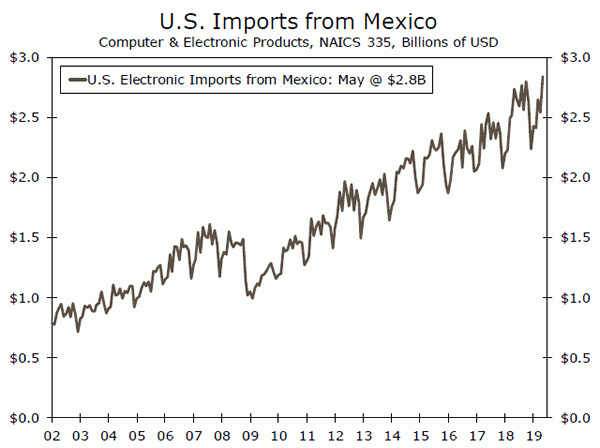
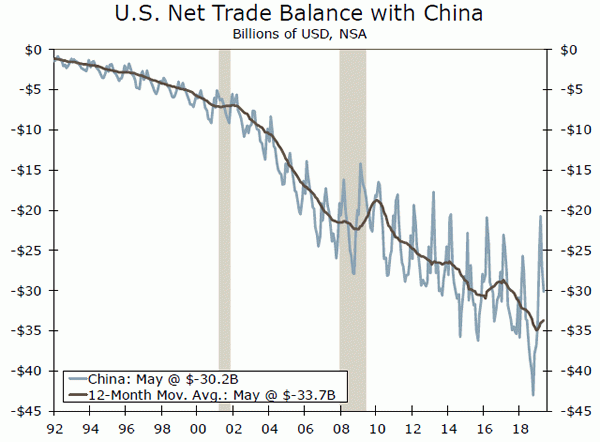


 Signal2forex.com - Best Forex robots and signals
Signal2forex.com - Best Forex robots and signals




